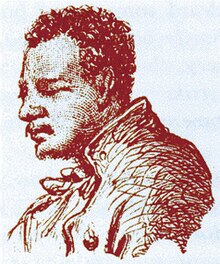Shields Green | |
|---|---|
 Green awaiting his trial after the Harpers Ferry raid | |
| Born | c. 1836 South Carolina, U.S. |
| Died | December 16, 1859 (aged 22–23) |
| Cause of death | Hanging |
| Resting place | Winchester, Virginia (grave unknown) |
| Other names | Emperor |
| Known for | Raid on Harpers Ferry |
| Criminal charges | Murder and inciting a slave insurrection; charge of treason dropped |
| Criminal penalty | Death by hanging |
| Criminal status | Executed |
Shields Green (1836? – December 16, 1859), who also referred to himself as "Emperor",[1]: 387 [2][3] was, according to Frederick Douglass, an escaped slave from Charleston, South Carolina, and a leader in John Brown's raid on Harpers Ferry, in October 1859.[1]: 387 [4] He had lived for almost two years in the house of Douglass, in Rochester, New York, and Douglass introduced him there to Brown.
Although Green survived the raid unwounded, he was tried, convicted, and executed by hanging on December 16, 1859, together with three other raiders. All the trials and executions took place in Charles Town, West Virginia (at the time Charlestown, Virginia), county seat of Jefferson County. At John Brown's execution two weeks prior, very few spectators were permitted, for security reasons. Now there were no restrictions, the judge wanted the executions to be seen by the public,[5] and there were 1,600 spectators.[6][7] At the time, legal as well as illegal hangings were entertainment.[8][9]
Green was the only one from the raid on Harpers Ferry that Frederick Douglass mentioned alongside iconic rebels Nat Turner and Denmark Vesey;[10][11][12] Douglass "eulogized [him] with rare pathos".[13][14]: 27 In an article on courageous negroes who revolted he is mentioned alongside Douglass himself and Haitian leader Jean-Jacques Dessalines.[15][16] In Silas X. Floyd's Floyd's Flowers, or Duty and Beauty for Colored Children, Green is a Black hero like Crispus Attucks, Toussaint l'Ouverture, or Benjamin Banneker.[17] Floyd calls him a martyr.
- ^ a b Cite error: The named reference
Douglasswas invoked but never defined (see the help page). - ^ Lee, Robert E. (1902). "Col. Robert E. Lee's Report. Headquarters Harper's Ferry. October 19, 1859". The John Brown Letters. Found in the Virginia State Library in 1901 (continued). Vol. 10. pp. 17–32, at p. 22. JSTOR 4242480.
{{cite book}}:|journal=ignored (help) - ^ Mason, James M.; Collamer, Jacob (June 15, 1860). Report [of] the Select committee of the Senate appointed to inquire into the late invasion and seizure of the public property at Harper's Ferry. p. 42.
- ^ ASR (March 21, 1995). "John Brown: The Conspirators [sic] Biographies". Archived from the original on 2018-06-07. Retrieved May 21, 2007.
- ^ "(Untitled)". Hartford Courant. Hartford, Connecticut. November 15, 1859. p. 2 – via newspapers.com.
- ^ "The executions at Charlestown". Pittsburgh Post. December 17, 1859. p. 1. Archived from the original on 2020-10-16. Retrieved 2020-10-16 – via Pennsylvania News Archive.
- ^ "Execution of the Insurgents". Tyrone Star. Tyrone, Pennsylvania. December 24, 1859. p. 2 – via newspapers.com.
- ^ "Harper's Ferry". Pontiac Gazette. Pontiac, Michigan. December 16, 1859. p. 2 – via Digital Michigan Newspapers.
- ^ "Expulsion of strangers". New-York Tribune. November 16, 1859 [November 12, 1859]. p. 6 – via newspapers.com.
- ^ Douglass, Frederick (September 1861). "Fighting Rebels With Only One Hand". Douglass' Monthly. African American Newspapers. Vol. 4, no. 4. p. 516 – via Accessible-Archives.com.
- ^ Douglass, Frederick (March 5, 1863). "A Call to the Negroes to Arm. Appeal from Frederick Douglass". The Evening Post. New York, New York. p. 1. Archived from the original on 2023-07-15. Retrieved 2021-03-05 – via NYS Historic Newspapers.
- ^ "A Call from Fred Douglass". Cleveland Daily Leader. Cleveland, Ohio. March 6, 1863. p. 2 – via newspapers.com.
- ^ "John Brown". Boston Globe. December 17, 1873. p. 5. Archived from the original on February 1, 2021. Retrieved January 27, 2021 – via newspapers.com.
- ^ Cite error: The named reference
Storerwas invoked but never defined (see the help page). - ^ Adams, Mary (May 1, 1928). "Record of revolts in negro workers' past". Daily Worker. Via Old Fulton New York Post Cards.
- ^ Allen, James Egert (May 16, 1970). "Black History Past and Present". New York Amsterdam News. p. 17. Via Old Fulton New York Post Cards.
- ^ Dyer, Thomas G. (1976). "An Early Black Textbook: Floyd's Flowers or Duty and Beauty for Colored Children". Phylon. 37 (4): 359–361. doi:10.2307/274499. JSTOR 274499.
